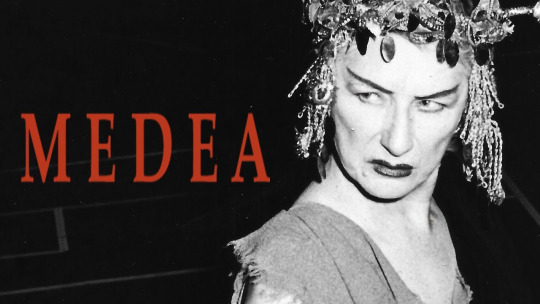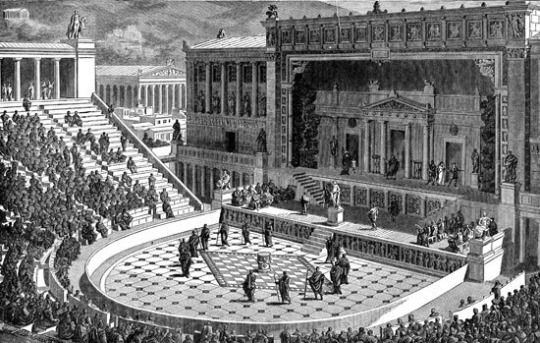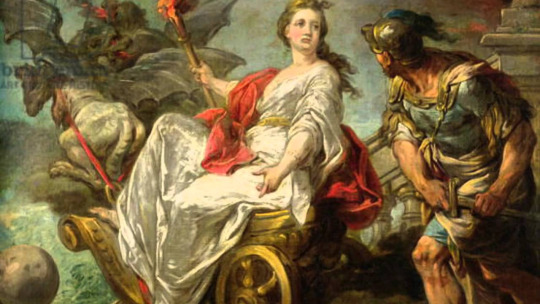Don't wanna be here? Send us removal request.
Text
Review of Jerffers' Medea Adaptation.
Disclamer: I am a student of the University of Hull blogging as part of my assessment for the module Drama, Conflict, and Identity. All views expressed here are my own and do not represent the university

A review of Jeffers' adaptation of Medea: This was televised in 1959. This production can be found easily on youtube - MEDEA (1959) JUDITH ANDERSON. This is an adaptation of the originally written Medea by Euripides from the 5th-century Ancient Greek Theatre. At the time this play was considered unorthodox and groundbreaking - to create catharsis for audiences to release their emotions of frustration through a play. This gives us the necessary context for a fuller understanding of the play we are reviewing - Jeffers’ Adaptation of Medea.
Jeffers’ adaptation of Medea uses technical differences from the original playwright of Medea to cater to its television audience. One example of this is the use of elevated stairs with several levels in this play adaptation. This aids with depth perception in the production as characters - specifically Medea herself interacts with characters from different steps and heights. This allows the characters to travel to and from each other creating a more open performance that seems more realistic to a viewer who would be watching the filming of the play rather than being in the audience. Furthermore, throughout the play the more powerful characters stand higher up on the set - especially at the end of the performance as Medea stands over a sobbing Jason - this depicts how this adaptation used these stairs to depict the more powerful characters. Moreover, this feeling of the audience walking closer and further away from the camera greatly helps to mirror the conventional use of ancient Greek theatres of the parodoi - a lengthy walkway that actors could use to move towards and from the audience. This adds depth and a more inclusive feeling to this television adaptation of Medea by mirroring ancient Greek theatre layouts with a camera and set work. This idea is further reinforced by Jeffers’ use of a door in the center of the set - mirroring the use of skene in ancient Greek cinema. This central door would have been used to hide characters offstage to increase the gory images and possibilities created by the imagination of the audience. This was achieved as they only heard the screams and horrors of Medea in the first act, rather than also seeing her character. This adds an almost psychological horror to the performance as the imagination of the viewer runs wild. This not only adds depth to this high-level performance of Medea but also showcases the actress's wide range of dramatic acting abilities through a wider mode of dramatic performance.

Moving onto how the actors are dressed in this performance of Medea; The costumes in this performance attempt to portray the conventional dresses of the ancient Greeks at the time of Medea’s setting. This is seen through long robes for both the male and female actors as well as what is presumably jewellery for those of higher social status - the type of precious metal however is difficult to determine due to the black and white recording of this adaptation of medea. Through the use of conventional ancient greek theatre clothing this adaptation of Medea doesn’t necessarily need to utilise the authentic greek masks of theatre. In the original showings of Medea - a Greek tragedy, there would only be 3 or 4 actors on stage at any time utilising masks to portray identity. The lack of mask use and more than four actors in Jeffers’ adaptation moves away from the conventional Greek theatre norm. This however calls for some interesting character interaction with more gon g on stage between Medea and other characters as well as a larger chorus on stage. This therefore allows for more in depth character interaction - allowing for an after paced performance and a more in depth exploration of medea’s character as she interacts with more characters at once.
I'd like to further discuss the ideas surrounding conflict and identity that are portrayed in this adaptation of Medea. Upon watching the 4th act of this adaptation we see an interaction between Medea, Jason and their two sons - all of which are on stage at the same time during this scene. This scene sets up perfectly to release catharsis for one of the ending scenes of its production at around 1:34:00. In this heart wrenching scene we see Medea give a soliloquy of her outrage and hatred for Jason, followed by the revealing of her dead sons. This production carefully crafted an intense reveal for the death of the sons with the use of a large door in the middle of the scene - very similar to a skeen in the original playwright of medea. The large doors centre to the camera open to reveal the dead bodies of both sons as Jason writhes in pain.
This scene explores issues of identity and conflict as the atypical mother identity of Medea is portrayed. This can be inferred by what can only be described as a direct juxtaposition to a nurturing and loving mother as she strikes down her own children in her youth. Thai not only allows for the audience to release catharsis but makes the audience question their own identity as they consider just how easy it was for, what was previously a loving mother, to commit such a heinous act. This therefore creates a conflicting identity among the character of Medea - therefore opening up connotations of nature vs nurture, making the audience wonder whether evil is inherited or nurtured into them This scene overall provided great insight and questioning into how identity is created and by asking - why is Medea seemingly so evil?
The ideas surrounding conflict are also prevalent in this scene, as we see Medea and Jason arguing throughout. Conflict is presented throughout this production through these characters arguing over faithfulness and love - with this scene providing a climax, ultimately ending with Jason begging for mercy to see his dead sons. Contetxally as an ancient Greek tragedy, this idea would be highly atypical, completely changing the gender roles and narratives surrounding power in a relationship with the man begging for mercy at the hands of his wife. This changes the narrative of gender roles whilst also providing meaningful insight into what conflict is - suggesting it's both an emotional and physical battle rather than just a physical one. Applying this production, the idea surrounding gender roles are much more accepted as women and men being equal – however, the idea surrounding conflict being a battle of mentality is still very prevalent and may give the audience an insight into what conflict really is and an insight into true hardship.

Overall both themes of identity and conflict are shown in this production as a whole and, specifically in the closing scenes of this production. This adaptation mold well to the new technology of television (which is how it was shown to audiences) whilst also staying true to the strength surrounding Euripedea’s original production o Fmedea - such as the use of a skene and the cultural questions surrounding the power of gender conflict and identity. This production is overall a great watch and really provides insight and entertainment at the same time, furthermore, this may serve as a useful resource when studying Mdea as the play is easier to visualize when being watched rather than read.
Link to this performance: MEDEA (1959) JUDITH ANDERSON
2 notes
·
View notes